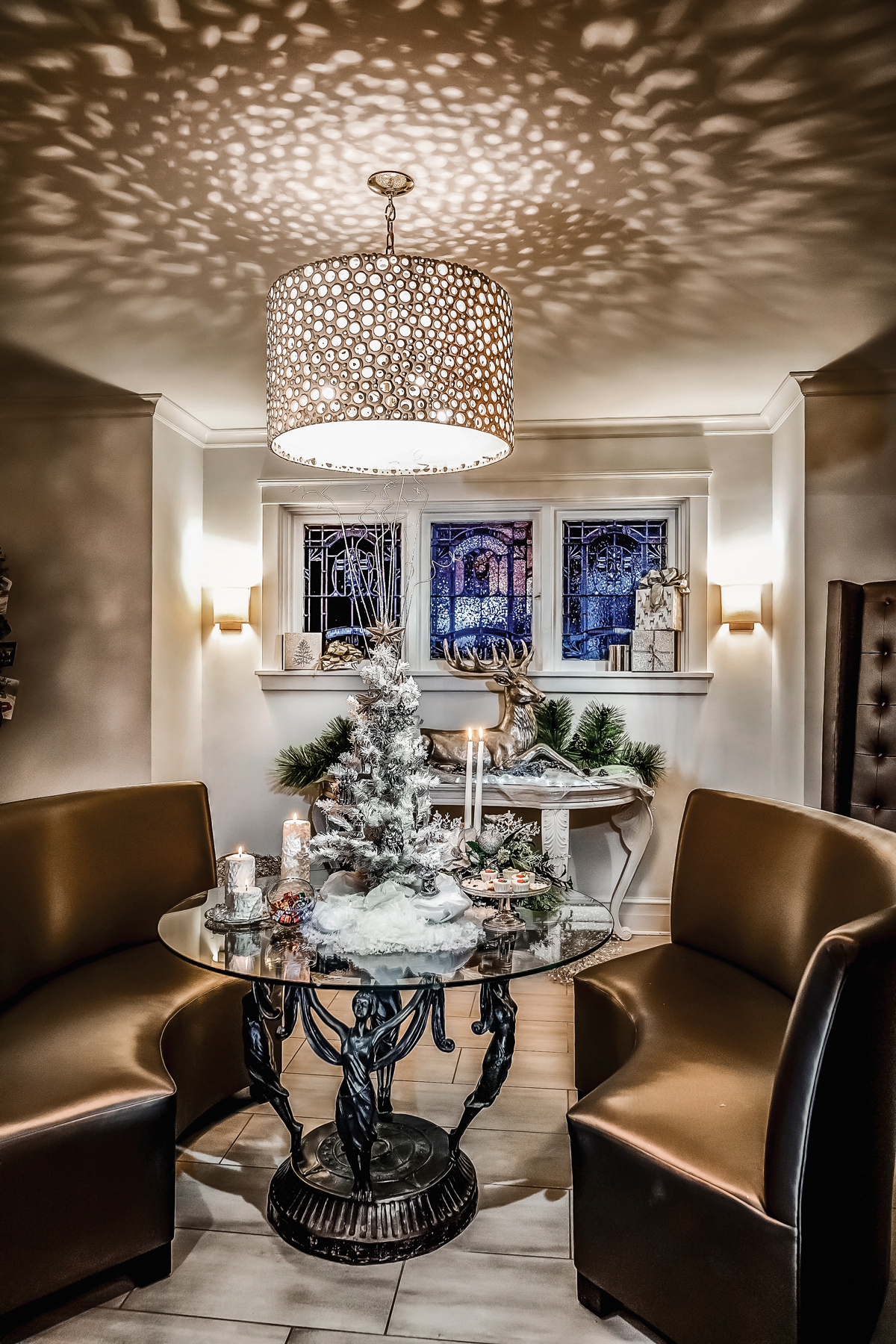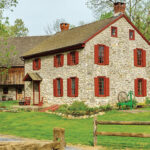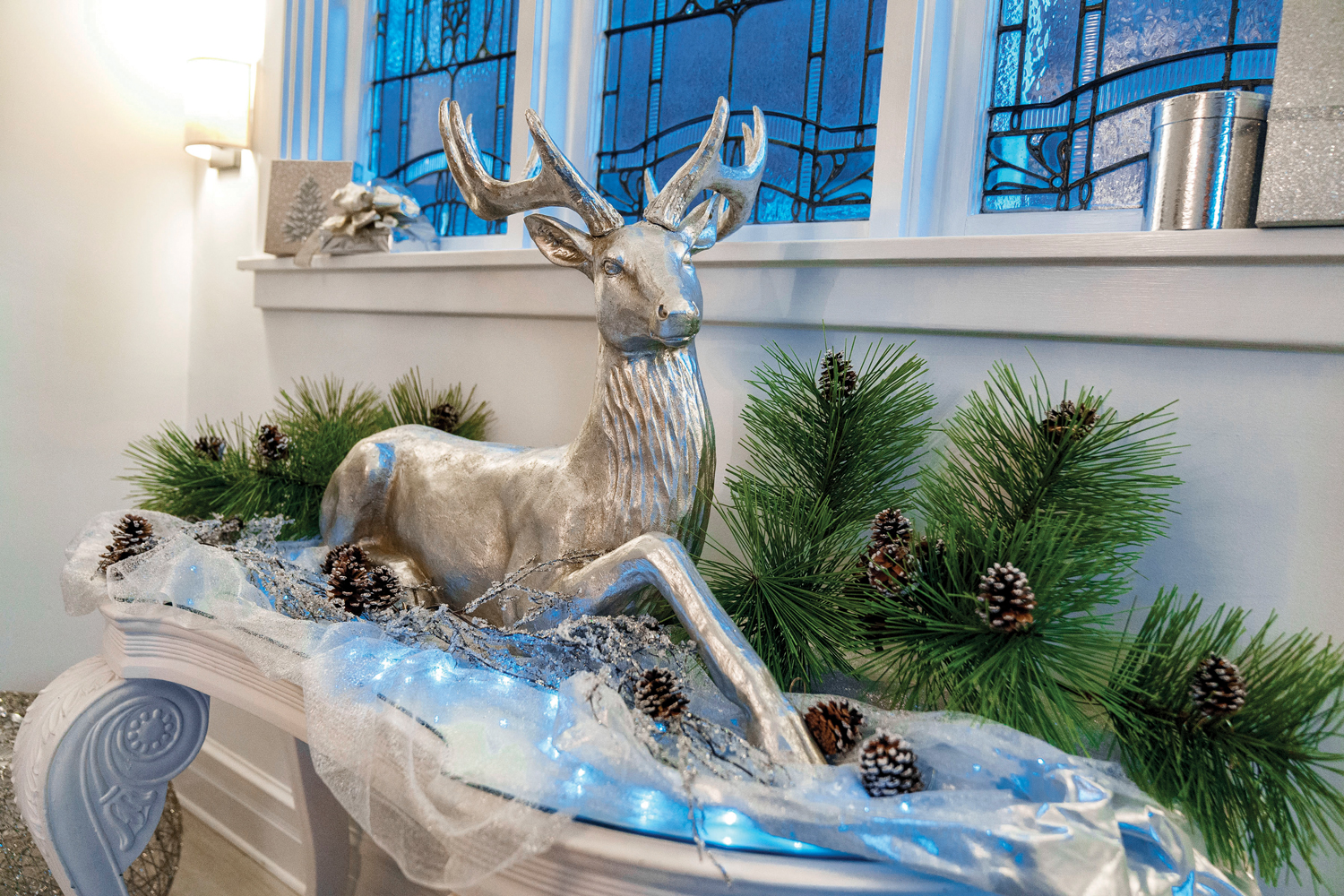Elaine and Glenn Pottberg’s home in Lancaster provides the perfect backdrop for the holiday decorations they’ve collected over the years. Dating to 1921, the house was built as a wedding gift from Andrew H. Rote to his bride, Mildred. It was designed by none other than C. Emlen Urban.

The red blow-mold bells were purchased during Watt & Shand’s closing sale, while the door wreath once decorated Hess’s Department Store. If memory serves her correctly, Elaine believes the garland on the columns was purchased from a furniture store that closed in Quarryville.
The Pottbergs, who are the second owners of the house, continued the wedding gift tradition, as they purchased the house soon after they were married 30 years ago. “It was in pristine condition,” Elaine recalls of the Colonial-Revival design, whose exterior (according to Lee J. Stoltzfus/Lancaster Streetscape) features “bands of soldier coursing, with decorative stone lozenges and keystones.” He goes on to describe it as having “a wood cornice with modillions” and “Tuscan columns that support the arched hood over the entry.” The Pottbergs also took note of the interior’s defined spaces. “It was obvious the house had been well taken care of,” Elaine says. (Mr. Rote died in 1957, while Mrs. Rote lived there until she was well into her 90s.) However, it had not been updated from a decorative standpoint. “It was a sea of avocado green and golden harvest colors. Shag rugs covered the floors,” she says.
Incredibly, many of Urban’s upscale design elements had survived. For example, the beautiful hardware on the doors remained intact (along with each and every skeleton key). The electrical outlets were also interesting, as they were moveable and ran along a track. “I guess if you wanted to move the furniture, you could reposition the outlets,” Elaine surmises.

The Pottbergs’ home dates to 1921 and was designed by C. Emlen Urban. They bought it from its original owner, Mildred Rote, the widow of Andrew H. Rote, 30 years ago. The Pottbergs possess the original deed to the house.
In the dining room, a doorbell was positioned on the floor beneath the dining table so that servants could be summoned. The floor in the room intrigued Elaine. “It was a high-end, trimmed-out linoleum from the ’20s – from Armstrong – that looked very Deco,” she says of the burgundy, black and gold color scheme. The adjacent butler’s pantry held a dumbwaiter (that still functions today).
While the Pottbergs deemed that cosmetic changes were needed, they were determined to honor and retain the bones of the house. “Fortunately, it was left the way Urban designed it,” says Glenn, referring to elements such defined rooms, original stained glass and the wavy glass that comprises the windows. “It hadn’t been ‘remodeled’ like so many older homes are.” Over the years, the couple have created an outdoor living area in the backyard, replaced the kitchen (“only because the metal cabinets were rusting,” says Elaine), installed new flooring on the main level, repainted and updated the lighting fixtures.
Christmas, Inc.
At Christmas, the Pottbergs’ home shines! Big, bold and dramatic is the direction Elaine likes to take in decorating the house. “I think that comes from my mom,” she says of the late Lois Jean Matos, who loved knickknacks. “She had them everywhere!” Elaine remembers. “It was my job to dust them. I couldn’t stand doing that! And she wanted them to be put back exactly as I found them, which was impossible. I think that’s what sent me off in the other direction. If I go into a store, I always look for something big.”

The Deco-inspired dining room pays homage to the original décor the Pottbergs discovered when they toured the house ahead of buying it 30 years ago.
Big and dramatic also led her to develop a unique shopping plan. Elaine discovered that when a store closes its doors for good, everything is sold … right down to the Christmas decorations, which are usually oversized. “I started shopping that way 40 years ago,” she says. “I stored my finds at Lancaster Storage.”
Her biggest “get” is undoubtedly the red bells that glow in the front entrance to the house. They came from the Watt & Shand store, as did the Plaster of Paris candles she snagged. The bells were made through a process called blow mold (liquid plastic was poured into a mold to create the decorations.)
Blow-mold decorations hit the market in the 1940s and became hugely popular thanks to a garden fixture created by Don Featherstone, who went to work for the Union Products company after graduating from art school. His creation was the pink flamingo that graced lawns from Miami to Anchorage. Their popularity inspired decorations for Christmas, Halloween and Easter. The must-have Christmas decorations were a fixture on lawns from the ’50s to the early ’70s. “I can’t tell you how many people ask us if they can take a family picture with the bells,” says Elaine.
Elaine has discovered that vintage blow-mold decorations are back in vogue. “The younger generations love them,” she says of the vintage models. “I have a long list of people who want to buy the bells should I want to sell them.” The resurgence in the popularity of blow-mold figures has even prompted manufacturers to resume production. So, if you happen to see a vintage blow-mold Santa, snowman or reindeer (remember the set in National Lampoon’s Christmas Vacation?) at a garage sale or flea market, grab it!

Elaine purchased the succulent wall art long before the plants became popular and discovered it made for the perfect way to display holiday cards.
The “store closing” decorations that complement the bells include the door wreath (from Hess’s Department Store, which closed in 1973), while the garland on the columns was purchased from a furniture store that closed in Quarryville. The large deer that sits atop a table in the dining room was purchased when Rebman’s closed in 2005 (who hasn’t forgotten the Moon Room?), as were a 7-foot candy cane and mercury glass ornaments. “That deer is solid wood,” Elaine reports.
The sterling-silver decorations on a tabletop tree came courtesy of Appel & Weber (a jewelry store acquired by Watt & Shand in 1959). “I wish I had more from the downtown stores,” Elaine laments. Of late, she’s added to her collection by shopping Wolf Furniture and Pier One’s closing sales (2020). “I bought every roll of wrapping paper from Pier One that had a deer imprinted on it,” she reports.
As she ticks off her “suppliers,” Glenn jokes that even after 30 years of being married to Elaine, he becomes “very afraid” when he hears a store is closing, as it means she will be on the hunt for a find of some kind.
Expanding Her Horizons
Glenn isn’t as innocent as he makes you believe; he’s definitely Elaine’s partner in bargain hunting. One of their favorite getaways is the World’s Longest Yard Sale (aka the 127 Sale), which is held over four days in early August and covers nearly 700 miles along Route 127, from Michigan to Alabama. Begun in 1987 as a way to lure travelers off the interstates and onto rural America’s backroads, the yard sales have achieved their goal, as shoppers and pickers arrive from all over the country. You would not believe the blow-mold decoration Elaine and Glenn found this year (can’t give too much away, as it’s destined to be a Christmas gift for someone special). “I found out about the event through Architectural Digest,” Elaine says, noting she was able to buy her niece very high-end lighting fixtures for her new home through an electrician who gave his mother a barnful of excess fixtures to sell during the event.

Last year’s decorating theme centered on silver, which enabled Elaine to put the wrapping paper she purchased from Pier One’s closing sale to use.
Another favorite hunting ground is the Brimfield Antique Flea Market in Massachusetts. Held three times a year, the markets (now in operation for more than 50 years) attract vendors from all over the country (and abroad). “I have some favorite vendors I always check out,” she reports, including one who makes accessories from cement for Anthropologie.
Ah, but Elaine doesn’t stop there. Hotels, restaurants and other venues offer a treasure trove of furnishings and accessories. A fabulous table in the dining room was scored when the Waldorf Astoria Hotel in New York held a sale of furnishings ahead of undergoing a redecorating project. A coffee table was purchased from a similar sale that was conducted for a casino in Atlantic City. Elaine also likes to go straight to the source – High Point, North Carolina – for furnishings such as the pieces she bought when she redecorated the dining room.
Christmas 2024
Elaine begins to think about Christmas decorating as early as August. “I never like to do the same thing twice,” she says. Last year’s silver-themed décor will revert to red this year. She also plans to celebrate the season with lots of friends and food, which will tie into her décor. She’s planning to use up some of that holiday paper by wrapping a multitude of packages (filled with gift items) and using them as decorations. (Think Santa’s workshop.) Her plan is that as guests leave, they’ll take a gift home with them. Think about it: she’s solved the drudgery of having to take down holiday decorations. Glenn has questions: how will she know how many to wrap, what if she runs out … “I’ll figure it out later,” she assures him.














Wonderful article beautiful home